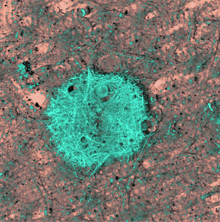Research Matters
November 24, 2008 Imaging Compound May Help Predict Alzheimer’s DiseaseA new brain imaging study has found that elderly people can develop a key hallmark of Alzheimer’s disease in the brain without any evidence of cognitive impairment. The researchers hope that their detection method will one day help predict who will develop Alzheimer’s disease in 5 to 10 years.  A region of amyloid plaque in the brain of a person
with Alzheimer's disease. Image by Medical Microscopy
Sciences, Cardiff University. All rights reserved by Wellcome
Images.
Currently, doctors can only make a definitive diagnosis of Alzheimer’s disease by examining the brains of patients after death. The ability to diagnose Alzheimer’s disease earlier would allow researchers to test possible drugs sooner in the course of the disease, raising the odds of identifying effective therapies. New technology has made it possible to visualize a primary hallmark of Alzheimer’s disease, the presence of protein clumps called beta amyloid deposits, within living brains. Dr. William Klunk at the University of Pittsburgh School of Medicine is co-inventor of a substance called Pittsburgh Compound B, or PiB, that binds to beta amyloid deposits in the brain. In their new study, which was funded by NIH’s National Institute on Aging (NIA), National Institute of Mental Health (NIMH) and others, Klunk’s team recruited elderly people, aged 65-88, who didn’t meet the criteria for dementia or the mild cognitive impairment that often precedes it. The 43 people who completed the study had no major differences in education levels, IQ scores or other key demographic traits. All were evaluated cognitively using a battery of perceptual and memory tests. The participants were injected intravenously with radiolabeled PiB and subsequently given a brain scan with positron emission tomography. The results, published in the November 2008 issue of Archives of Neurology, showed that a significant portion (21%) of cognitively unimpaired elderly individuals showed beta amyloid deposition in brain regions that are known to develop beta amyloid deposits in Alzheimer’s disease patients. “The results show that we can detect amyloid deposits before patients develop symptoms of Alzheimer’s disease,” Dr. Klunk said. Identifying this critical time window will be essential in aiding future efforts to develop successful anti-amyloid therapies. Surprisingly, the amyloid-positive subjects showed cognitive performance that was no worse than that of the amyloid-negative group. “We suspect that people with amyloid deposits and normal brain functioning have a high risk of developing Alzheimer's disease in the future, but we do not yet have proof of this,” Dr. Klunk explained. Further studies with more subjects and over longer periods of time will be needed to definitively show whether early detection of amyloid deposits in living brains can help predict the development of Alzheimer’s disease. —by Dario Dieguez, Jr., Ph.D. Related Links:
Blood Protein Helps Assess Cardiovascular Risks Ginkgo Study Fails To Find Benefit in Preventing Dementia Imaging Compound May Help Predict Alzheimer’s Disease This page was last updated
November 24, 2008
.
|



